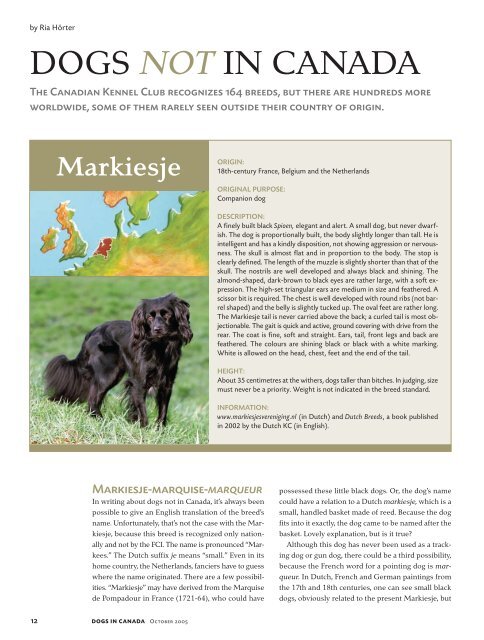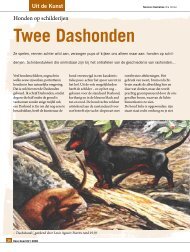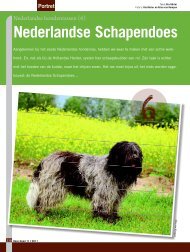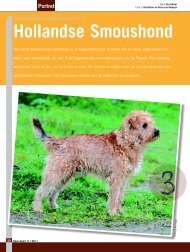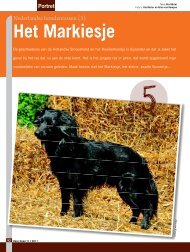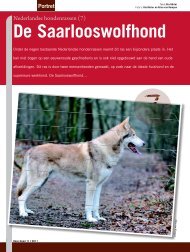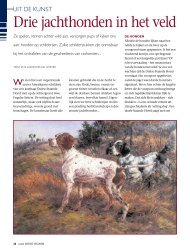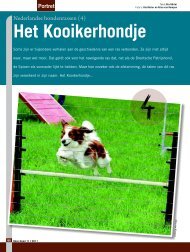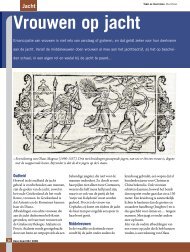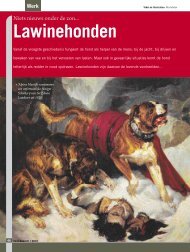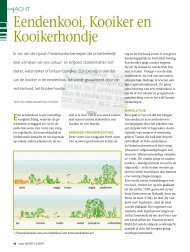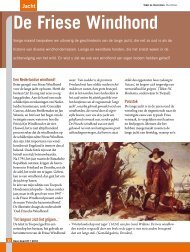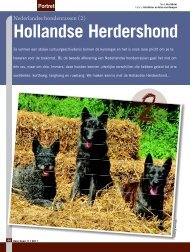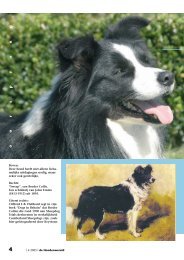Dogs Not in Canada - Markiesje - Ria Hörter
Dogs Not in Canada - Markiesje - Ria Hörter
Dogs Not in Canada - Markiesje - Ria Hörter
You also want an ePaper? Increase the reach of your titles
YUMPU automatically turns print PDFs into web optimized ePapers that Google loves.
y <strong>Ria</strong> <strong>Hörter</strong><br />
DOGS NOT IN CANADA<br />
The Canadian Kennel Club recognizes 164 breeds, but there are hundreds more<br />
worldwide, some of them rarely seen outside their country of orig<strong>in</strong>.<br />
<strong>Markiesje</strong><br />
ORIGIN:<br />
18th-century France, Belgium and the Netherlands<br />
ORIGINAL PURPOSE:<br />
Companion dog<br />
DESCRIPTION:<br />
A f<strong>in</strong>ely built black Spioen, elegant and alert. A small dog, but never dwarfish.<br />
The dog is proportionally built, the body slightly longer than tall. He is<br />
<strong>in</strong>telligent and has a k<strong>in</strong>dly disposition, not show<strong>in</strong>g aggression or nervousness.<br />
The skull is almost flat and <strong>in</strong> proportion to the body. The stop is<br />
clearly def<strong>in</strong>ed. The length of the muzzle is slightly shorter than that of the<br />
skull. The nostrils are well developed and always black and sh<strong>in</strong><strong>in</strong>g. The<br />
almond-shaped, dark-brown to black eyes are rather large, with a soft expression.<br />
The high-set triangular ears are medium <strong>in</strong> size and feathered. A<br />
scissor bit is required. The chest is well developed with round ribs (not barrel<br />
shaped) and the belly is slightly tucked up. The oval feet are rather long.<br />
The <strong>Markiesje</strong> tail is never carried above the back; a curled tail is most objectionable.<br />
The gait is quick and active, ground cover<strong>in</strong>g with drive from the<br />
rear. The coat is f<strong>in</strong>e, soft and straight. Ears, tail, front legs and back are<br />
feathered. The colours are sh<strong>in</strong><strong>in</strong>g black or black with a white mark<strong>in</strong>g.<br />
White is allowed on the head, chest, feet and the end of the tail.<br />
HEIGHT:<br />
About 35 centimetres at the withers, dogs taller than bitches. In judg<strong>in</strong>g, size<br />
must never be a priority. Weight is not <strong>in</strong>dicated <strong>in</strong> the breed standard.<br />
INFORMATION:<br />
www.markiesjesverenig<strong>in</strong>g.nl (<strong>in</strong> Dutch) and Dutch Breeds, a book published<br />
<strong>in</strong> 2002 by the Dutch KC (<strong>in</strong> English).<br />
<strong>Markiesje</strong>-marquise-marqueur<br />
In writ<strong>in</strong>g about dogs not <strong>in</strong> <strong>Canada</strong>, it’s always been<br />
possible to give an English translation of the breed’s<br />
name. Unfortunately, that’s not the case with the <strong>Markiesje</strong>,<br />
because this breed is recognized only nationally<br />
and not by the FCI. The name is pronounced “Markees.”<br />
The Dutch suffix je means “small.” Even <strong>in</strong> its<br />
home country, the Netherlands, fanciers have to guess<br />
where the name orig<strong>in</strong>ated. There are a few possibilities.<br />
“<strong>Markiesje</strong>” may have derived from the Marquise<br />
de Pompadour <strong>in</strong> France (1721-64), who could have<br />
possessed these little black dogs. Or, the dog’s name<br />
could have a relation to a Dutch markiesje, which is a<br />
small, handled basket made of reed. Because the dog<br />
fits <strong>in</strong>to it exactly, the dog came to be named after the<br />
basket. Lovely explanation, but is it true?<br />
Although this dog has never been used as a track<strong>in</strong>g<br />
dog or gun dog, there could be a third possibility,<br />
because the French word for a po<strong>in</strong>t<strong>in</strong>g dog is marqueur.<br />
In Dutch, French and German pa<strong>in</strong>t<strong>in</strong>gs from<br />
the 17th and 18th centuries, one can see small black<br />
dogs, obviously related to the present <strong>Markiesje</strong>, but<br />
12 DOGS IN CANADA October 2005
DOGS NOT IN CANADA<br />
PHOTO AND ILLUSTRATION: COURTESY RIA HÖRTER<br />
Above: A Young Girl or The Pr<strong>in</strong>cess, by Dutch pa<strong>in</strong>ter Paulus Moreelse (1571-1638). (Rijksmuseum, Amsterdam.)<br />
Above, right: A photo taken around 1885 <strong>in</strong> the Netherlands. The lady on the left has a <strong>Markiesje</strong> on her lap.<br />
PHOTOS (RIGHT AND OPPOSITE): ALICE VAN KEMPEN<br />
also to the Dutch Spioen (Toy spaniel) and the French<br />
Papillon. The bitch ‘Pom,’ the ancestress of all present<br />
<strong>Markiesje</strong>s <strong>in</strong> the Netherlands, orig<strong>in</strong>ated from France,<br />
so maybe there is a l<strong>in</strong>k with the French word marqueur.<br />
More or less obsessed<br />
As <strong>in</strong> the history of other breeds, there is always someone<br />
to whom we owe the breed as it is today. That is<br />
certa<strong>in</strong>ly the case with the <strong>Markiesje</strong>. In 1963, a Dutch<br />
Phalène (drop-eared Papillon) breeder met a small dog<br />
belong<strong>in</strong>g to her neighbour’s mother. The owner called<br />
the dog a <strong>Markiesje</strong>. The breeder, Mia van Woerden,<br />
became more or less obsessed with discover<strong>in</strong>g the<br />
dog’s orig<strong>in</strong> and if it belonged to a certa<strong>in</strong> group of<br />
dogs and if so, <strong>in</strong> which country.<br />
At the same time, the famous Dutch dog writer Toepoel<br />
mentioned the <strong>Markiesje</strong> <strong>in</strong> one of his books: “This<br />
dog has been known <strong>in</strong> our country from the 18th century.<br />
It is a well-known lady’s dog like the K<strong>in</strong>g Charles<br />
Spaniel <strong>in</strong> England and the Papillon <strong>in</strong> Belgium. It is,<br />
however, a little larger and <strong>in</strong> appearance it rema<strong>in</strong>ed<br />
closer to the Spioen. The colour is black with usually<br />
some white on the chest and feet. Although never purebred,<br />
one can see them everywhere.” Toepoel predicted<br />
that “There is a possibility this breed can be restored.”<br />
Restor<strong>in</strong>g the breed<br />
From the beg<strong>in</strong>n<strong>in</strong>g, Mia van Woerden turned to the<br />
media to f<strong>in</strong>d dogs resembl<strong>in</strong>g the <strong>Markiesje</strong> she knew.<br />
She ma<strong>in</strong>ly used radio, newspapers and the dog press.<br />
There was a lot of response from people who owned<br />
dogs as Mia described, and there was sufficient visual<br />
material, for example several pa<strong>in</strong>t<strong>in</strong>gs, to be able<br />
to re-create the breed. It is said that the <strong>Markiesje</strong> had<br />
belonged ma<strong>in</strong>ly to wealthy families and royalty, which<br />
could be the reason we have quite a few pa<strong>in</strong>t<strong>in</strong>gs of<br />
its ancestors.<br />
DOGS IN CANADA October 2005 13
DOGS NOT IN CANADA<br />
As a result of Mia’s <strong>in</strong>vestigations, the first litters of<br />
<strong>Markiesje</strong> look-alikes were born. The results, however,<br />
were disappo<strong>in</strong>t<strong>in</strong>g. The gene pool was too small and<br />
the dogs far too big. A second attempt was made by<br />
us<strong>in</strong>g black-and-white Papillons from Sweden and<br />
England. Later, a Cavalier K<strong>in</strong>g Charles Spaniel was<br />
used as well. Aga<strong>in</strong> the result was poor. The dogs did<br />
not resemble Mia’s first love, the dog she had seen <strong>in</strong><br />
1963, and some hereditary diseases had cropped up.<br />
In the ’70s, a group of people formed around Mia<br />
with the common goal of restor<strong>in</strong>g this breed so conscientiously<br />
depicted <strong>in</strong> old pa<strong>in</strong>t<strong>in</strong>gs. In 1977, Mieke<br />
van Ederen, a friend of Mia’s, imported a small black<br />
Toy spaniel from France to the Netherlands. This was<br />
‘Pom’ (born <strong>in</strong> 1977), probably out of a black Papillon<br />
and by an unknown dog. Mia was delighted with this<br />
bitch; it was exactly the type she was look<strong>in</strong>g for. In<br />
1980, Mieke imported two males (nephews of Pom)<br />
and <strong>in</strong> 1981, five puppies. She bred Pom, who whelped<br />
three litters, the first <strong>in</strong> 1979, produc<strong>in</strong>g a total of 12<br />
puppies. Six of her offspr<strong>in</strong>g have been used for breed<strong>in</strong>g.<br />
Pom died at the age of 17, a dignified ‘mother of<br />
the breed.’ Mieke van Ederen is still very much <strong>in</strong>volved<br />
<strong>in</strong> the breed club and keeps a close eye on the<br />
breed<strong>in</strong>g program.<br />
Nationally recognized<br />
A breed club was established <strong>in</strong> June 1979 and recognized<br />
by the Dutch Kennel Club <strong>in</strong> 1985. The first breed<br />
standard was written <strong>in</strong> 1980, but wasn’t approved by<br />
breed club members until 1987. The <strong>Markiesje</strong> was<br />
recognized by the Dutch KC <strong>in</strong> May 1999.<br />
The first club show took place <strong>in</strong> 1987, with an entry<br />
of 38. Pom, then about 10 years old, was qualified as Excellent<br />
and her daughter ‘Fleur’ was Best Bitch and BB.<br />
Strict breed<strong>in</strong>g program<br />
In the first years, the dogs varied <strong>in</strong> type, size and colour<br />
– <strong>in</strong> fact, they were all colours of the ra<strong>in</strong>bow! However,<br />
thanks to some very dedicated fanciers and judges,<br />
the breed improved and gradually came to resemble<br />
the dog <strong>in</strong> the pa<strong>in</strong>t<strong>in</strong>gs. Such can be done only if there<br />
is a strict breed<strong>in</strong>g program and pa<strong>in</strong>stak<strong>in</strong>g registration<br />
of the litters. A report is still written about every<br />
litter and the breed is ‘guarded’ by qualified people.<br />
In 1996, the Dutch KC opened a provisional stud<br />
book for the Maskiesje; 139 dogs and bitches were entered<br />
and the <strong>Markiesje</strong> became eligible to be shown<br />
and qualified at national shows. A championship (CAC)<br />
cannot yet be won, but owners and breeders hope the<br />
Dutch KC will give permission for a CAC <strong>in</strong> 2006. About<br />
1,050 <strong>Markiesje</strong>s have now been entered <strong>in</strong>to the Dutch<br />
stud book; approximately 700 are still liv<strong>in</strong>g. The stud<br />
book is still open to dogs without a pedigree but approved<br />
by judges.<br />
Breeders and owners worked hard for more than<br />
40 years to realize Mia van Woerden’s dream: the restoration<br />
of a small, black, Toy, spaniel-like dog – the<br />
breed with a fasc<strong>in</strong>at<strong>in</strong>g name. And although Mia has<br />
now moved to Australia, she will never be forgotten<br />
as the one who ‘discovered’ this breed.<br />
Different k<strong>in</strong>d of sports<br />
Interest <strong>in</strong> the <strong>Markiesje</strong> <strong>in</strong> the Netherlands is substantial.<br />
The breed’s size is its advantage and the <strong>Markiesje</strong><br />
is popular <strong>in</strong> a number of sports, <strong>in</strong>clud<strong>in</strong>g agility,<br />
obedience and flyball. He is an excellent companion<br />
dog, and good with children. In 2004, a <strong>Markiesje</strong> won<br />
a competition among the n<strong>in</strong>e native Dutch breeds.<br />
The <strong>Markiesje</strong> is a friendly, happy and <strong>in</strong>telligent<br />
dog. The only th<strong>in</strong>g he wants to do <strong>in</strong> life is please his<br />
owner. He is <strong>in</strong>quisitive and will bark when he th<strong>in</strong>ks<br />
someth<strong>in</strong>g is wrong. As a result of crossbreed<strong>in</strong>g, colours<br />
other than solid black, and black with small white<br />
mark<strong>in</strong>gs, still pop up, but cannot be registered.<br />
The future<br />
Today, <strong>Markiesje</strong>s can be registered <strong>in</strong> the breed club’s<br />
<strong>Markiesje</strong> register and the Voorlopig register (provisional<br />
stud book of the Dutch KC). In the near future,<br />
it will be admitted to the Bijlagen (Appendix) of the<br />
kennel club’s stud book. The last step is the NHSB, the<br />
official stud book of the Dutch KC.<br />
A retired bookseller and publisher, <strong>Ria</strong> <strong>Hörter</strong> is a contribut<strong>in</strong>g<br />
editor of De Hondenwereld, the national dog magaz<strong>in</strong>e of Holland.<br />
PHOTO: JANNY OFFEREINS<br />
14 DOGS IN CANADA October 2005


